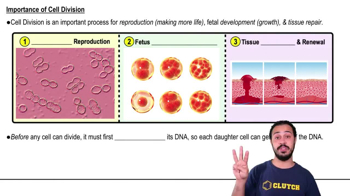Textbook Question
Which of the following is not a function of mitosis in humans?a. repair of woundsb. growthc. production of gametes from diploid cellsd. replacement of lost or damaged cells
2394
views
 Verified step by step guidance
Verified step by step guidance Verified video answer for a similar problem:
Verified video answer for a similar problem:



 9:40m
9:40mMaster Introduction to Cell Division with a bite sized video explanation from Bruce Bryan
Start learning